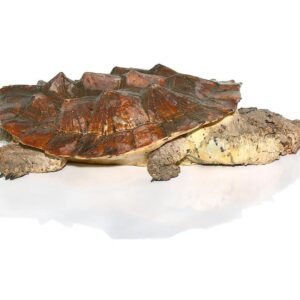Ornate Box Turtle for sale
$350.00
Other Names of Ornate Box Turtle
Desert Box Turtle
| ornate box turtle for sale |
Description
The carapace of the Ornate Box Turtle is relatively broad and oval, usually slightly flattened at the top, and lacks both a narrow keel lengthwise down the center and any flaring at the rear edge. The tallest point of the shell is just in front of the hinge on the plastron, so viewed sideways it’ll be tallest at the front of the turtle. The carapace is dark with many yellow lines, sometimes grouped into “starbursts” radiating downward, and the plastron is dark brown or black with a pattern similar to the carapace. There are almost always four toes on each hind foot. In older specimens of the ornate box turtle, the coloration may be more of a plain brown color.
| ornate box turtle for sale |
Habitat
Box turtles are “dry-land” turtles and may be found far from a water body. The ornate box turtle is usually found in open habitats: pastures, prairie and open woodland. This species is most active after rain, especially in drier habitats.
Class:
Reptilia
Order:
Testudines
Family:
Emydidae
Genus:
Terrapene
Species:
ornata
Life span:
30 – 40 years
Egg Gestation:
Females lay 3 – 8 eggs several times a year
incubation normally lasts 3 months
Number of young at birth:
3 – 8
Age of maturity:
8 – 10 years
Size:
Males are slightly larger than females. Average shell length is about 2 – 6 in. long
Weight:
0.5 – 1.5 lbs.
Description:
The turtle’s shell does have a fancy look to it. Each shell segment (scute) has a radiating pattern of yellow lines on a dark brown background.
Habitat: Open woodlands, pastures, and marshy meadows
Range: Eastern United States ranging from southern Maine to Florida along the East Coast, and west to Michigan, Illinois, eastern Kansas, Oklahoma, and Texas.
| ornate box turtle for sale |
Diet:
Snails, insects, berries, fungi, slugs, worms, roots, flowers, fish, frogs, salamanders, snakes, birds, and eggs
Fun Fact:
Strictly terrestrial turtles

Description
Ornate Box Turtle
The ornate box turtle, scientifically known as Terrapene ornata, is a captivating species that garners interest from both biologists and pet enthusiasts. This terrestrial turtle stands out due to its unique and intricate shell patterns, which serve as a natural form of camouflage in its native habitats. The shell, or carapace, of the ornate box turtle is typically adorned with yellow or orange lines radiating from the center of each scute, set against a dark brown or black background. This striking appearance is not only aesthetically pleasing but also plays a crucial role in the turtle’s survival.
In terms of size, the ornate box turtle is relatively small, with adults measuring between 4.5 to 6 inches in length. Its compact size, combined with its distinctive coloration, makes it easily recognizable. The turtle’s plastron, or underside, is usually lighter in color and features a hinge that allows it to close its shell tightly, providing protection against predators.
The habitat of the ornate box turtle spans across the central United States, where it thrives in prairies, grasslands, and open woodlands. This species is particularly adapted to a terrestrial lifestyle, favoring environments with loose, sandy soils that facilitate burrowing and nesting. The distribution of Terrapene ornata includes states such as Texas, Oklahoma, Kansas, Nebraska, and South Dakota, highlighting its preference for a region characterized by a mix of temperate climates and diverse ecosystems.
Biologists are drawn to the ornate box turtle due to its unique adaptations and ecological significance, while pet enthusiasts appreciate its manageable size and distinctive appearance. The study of this species provides insights into the broader ecological dynamics of its habitats and contributes to conservation efforts aimed at preserving North America’s native wildlife. As a result, the ornate box turtle remains a focal point of interest for both scientific research and responsible pet ownership.
The ornate box turtle, scientifically known as Terrapene ornata, is predominantly found in the central United States, where it thrives in a variety of environments. These turtles are particularly adapted to grasslands, prairies, and open woodlands, which provide the necessary conditions for their survival. These habitats offer ample sunlight, sandy or loose soils ideal for burrowing, and a diverse array of vegetation and invertebrates that constitute their diet.
Geographically, the ornate box turtle’s range extends from South Dakota and Wisconsin in the north, down through Kansas, Missouri, and Oklahoma, to Texas in the south. They are also found as far west as New Mexico and Colorado. In these regions, the climate conditions are characterized by warm summers and mild to moderately cold winters, which are crucial for the turtles’ seasonal activities.
Ideal climate conditions for the ornate box turtle include temperatures ranging from 70°F to 85°F (21°C to 29°C) during the active months of spring and summer. During these warmer months, the turtles are most active, engaging in foraging, mating, and basking in the sun. The availability of sunlight is essential as it helps them regulate their body temperature and facilitates the synthesis of vitamin D3, which is vital for their shell and bone health.
As the seasons change, so does the behavior and distribution of the ornate box turtle. In autumn, as temperatures begin to drop, these turtles start to prepare for brumation, a hibernation-like state. They seek out burrows or dig into the loose soil to insulate themselves from the cold. During winter, their activity significantly decreases, and they remain largely inactive until the arrival of warmer temperatures in spring.
Understanding the habitat and distribution of the ornate box turtle is crucial for conservation efforts. Protecting their natural environments from agricultural expansion, urban development, and other anthropogenic threats is essential to ensure the survival of this unique species.
Physical Characteristics and Behavior
The ornate box turtle (Terrapene ornata) is known for its distinctive and vibrant shell, which features intricate patterns of yellow lines and spots set against a dark brown or black background. This striking shell is not only visually appealing but also serves as a crucial protective barrier. The carapace, or upper shell, is dome-shaped and can reach lengths of approximately 4.5 to 6 inches in mature individuals. The plastron, or the lower shell, features a unique hinge that allows the turtle to completely enclose itself, offering added protection from predators.
Coloration and markings play a vital role in the identification of the ornate box turtle. Males typically exhibit brighter and more vivid shell patterns compared to females. Additionally, males often have red or orange irises, while females possess brownish eyes. The males also have slightly concave plastrons, which aid in mating, whereas females have flatter plastrons. These sexual dimorphisms are essential for distinguishing between the sexes during field observations.
Ornate box turtles are relatively small in size, with their compact stature contributing to their agility and ability to navigate through dense underbrush. They have a lifespan that can extend beyond 30 years in the wild, provided they are in a suitable and protected habitat.
In terms of behavior, ornate box turtles are primarily diurnal, meaning they are active during the day. Their diet is omnivorous, consisting of insects, small invertebrates, fruits, and vegetation. This varied diet ensures they receive a balanced intake of nutrients, which is vital for their health and survival. They are known for their foraging behavior, often seen digging in leaf litter or soil to uncover food sources.
Unique adaptations, such as their ability to completely close their shells, help them evade predators. Additionally, their keen sense of smell aids them in locating food, while their sharp claws are excellent for digging and climbing. These behavioral traits and physical characteristics enable the ornate box turtle to thrive in its natural habitat, despite the challenges they may face from environmental changes and human activities.
Reproduction and Lifespan
The reproduction cycle of the ornate box turtle is an intricate and fascinating process. Mating typically occurs in the spring, following a complex series of courtship behaviors that include males circling females and displaying vibrant head movements. Males possess a concave plastron, aiding in mounting the female during mating. Once mating is successful, females seek out suitable nesting sites, which are usually well-drained, sandy or loamy soils where they can dig nests to lay their eggs.
The nesting process involves the female using her hind legs to excavate a shallow hole where she deposits a clutch of eggs, generally ranging from three to eight. The eggs are then covered with soil to protect them from predators and environmental conditions. The incubation period for ornate box turtle eggs spans approximately 70 to 90 days, heavily influenced by temperature and humidity levels. Warmer temperatures tend to accelerate development, while cooler climates may prolong it.
Upon hatching, the young turtles face a precarious start to life, as they must dig their way out of the nest and are immediately exposed to potential predators. Hatchlings are independent from birth, receiving no parental care, and must rely on instinctual behaviors for survival, such as foraging for food and seeking shelter. Their diet mainly consists of insects, small invertebrates, and plant material, which provides essential nutrients for growth.
The average lifespan of an ornate box turtle varies significantly between wild and captive environments. In the wild, they often live up to 30 years, though predation, habitat destruction, and environmental factors can impact their longevity. In captivity, with proper care, diet, and habitat management, ornate box turtles can thrive for over 50 years. Key factors that influence their lifespan include diet quality, access to clean water, temperature regulation, and protection from predators and disease.
Diet and Nutrition
The ornate box turtle (Terrapene ornata) exhibits omnivorous dietary habits, adapting its food intake based on seasonal availability and environmental conditions. In their natural habitat, these turtles consume a diverse array of food sources. Their diet includes insects like beetles, grasshoppers, and caterpillars, which provide essential proteins. They also forage for various plants, fruits, and mushrooms, enriching their diet with necessary vitamins and minerals. On occasion, ornate box turtles may consume small animals such as amphibians and carrion, further supplementing their nutritional intake.
Seasonal changes significantly influence the dietary patterns of ornate box turtles. During the spring and summer months, when food is abundant, they predominantly feed on insects and fresh vegetation. As the seasons transition into autumn, their diet shifts more towards fruits and other available plant matter. In the winter, food scarcity leads them to rely on stored body fat and whatever limited food sources they can find. This seasonal adaptability is crucial for their survival in the wild.
When caring for ornate box turtles in captivity, replicating their natural diet as closely as possible is essential for their health and well-being. A balanced diet should consist of a mix of animal and plant-based foods. Protein sources can include commercially available insect varieties such as crickets and mealworms, as well as occasional offerings of lean meats or fish. Leafy greens, vegetables, and fruits like strawberries, apples, and melons should form the bulk of their plant-based diet.
It is important to avoid overfeeding any single category of food to prevent dietary imbalances. Providing a varied diet ensures that the turtles receive all necessary nutrients. Additionally, supplementation with calcium and vitamin D3 is recommended to support shell health and overall development. Fresh, clean water should always be available for drinking and soaking, as hydration is a critical component of their well-being.
Monitoring the diet and making necessary adjustments according to the turtle’s age, health, and seasonal changes will contribute to the longevity and vitality of ornate box turtles in captivity.
Conservation Status and Threats
The ornate box turtle (Terrapene ornata) is currently classified as “Near Threatened” by the International Union for Conservation of Nature (IUCN). This designation indicates that the species is close to qualifying for or is likely to qualify for a threatened category in the near future. Several factors contribute to the declining population of this species, making conservation efforts crucial.
One of the most significant threats to the ornate box turtle is habitat destruction. Urban expansion, agricultural development, and infrastructure projects often lead to the fragmentation and loss of their natural habitats, such as prairies and grasslands. This not only reduces the available living space for the turtles but also isolates populations, making it harder for them to find mates and reproduce.
Climate change is another critical threat. Alterations in temperature and precipitation patterns can affect the availability of food and suitable nesting sites. Additionally, extreme weather events, such as droughts and floods, can directly harm the turtles and their habitats. Climate-induced changes can also disrupt the hibernation cycles of ornate box turtles, further impacting their survival.
Predation and human interference also pose significant risks. Predators such as raccoons and skunks often target eggs and young turtles, while adult turtles are sometimes collected illegally for the pet trade. Road mortality is another concern, as turtles are frequently killed while attempting to cross highways and roads.
Conservation efforts are underway to address these challenges. Organizations and governmental bodies have implemented various programs aimed at habitat preservation and restoration. Legal protections, such as restrictions on collection and trade, have been established in several regions to safeguard the species. Additionally, captive breeding programs play a vital role in maintaining genetic diversity and potentially reintroducing individuals into the wild.
Overall, the survival of the ornate box turtle depends on continued and enhanced conservation measures. By addressing the primary threats and promoting sustainable practices, it is possible to protect and preserve this unique species for future generations.
Caring for Ornate Box Turtles as Pets
Keeping ornate box turtles as pets requires a comprehensive understanding of their specific needs to ensure their health and well-being. Proper housing is crucial; a spacious enclosure is essential, with dimensions of at least 4 feet by 4 feet for an adult turtle. The enclosure should include both terrestrial and aquatic elements, mimicking their natural habitat. A substrate mix of soil, sand, and leaf litter allows for natural digging and burrowing behaviors.
Lighting and temperature control are vital aspects of caring for ornate box turtles. They require a basking area with a temperature of 85-90°F, while the ambient temperature should be maintained between 70-75°F. UVB lighting is essential for their shell health and calcium metabolism, replicating natural sunlight. It is recommended to provide 12 hours of light and 12 hours of darkness to simulate their natural environment.
Humidity levels should be kept between 60-80%, which can be achieved by regular misting and providing a shallow water dish for bathing. Monitoring and maintaining these environmental parameters can prevent health issues related to improper care, such as respiratory infections or shell deformities.
The dietary needs of ornate box turtles are diverse; they are omnivores and require a balanced diet. A mix of leafy greens, vegetables, fruits, and protein sources like insects or commercial turtle pellets ensures they receive necessary nutrients. Calcium and vitamin supplements should be provided to prevent deficiencies.
Regular health check-ups with a veterinarian experienced in reptile care are recommended. These check-ups can help detect and address health issues early, ensuring the longevity and vitality of the turtle.
Enrichment activities are important to keep box turtles active and mentally stimulated. Providing climbing structures, hiding places, and opportunities for exploration can significantly enhance their quality of life.
Lastly, it is essential to consider the ethical and legal responsibilities of owning an ornate box turtle. Ensure that the turtle is acquired from a reputable source and not taken from the wild, as wild populations are often protected. Familiarize yourself with local regulations regarding turtle ownership to ensure compliance and contribute to conservation efforts.
Interesting Facts and Myths
The ornate box turtle, scientifically known as Terrapene ornata, is a captivating reptile with a rich array of intriguing facts and myths surrounding it. One remarkable fact about the ornate box turtle is its longevity; these turtles can live up to 40 years in the wild, and even longer in captivity under optimal conditions. This impressive lifespan is due to their slow metabolism and the ability to conserve energy during periods of dormancy.
An interesting characteristic of the ornate box turtle is its hinged plastron (the lower part of its shell), which allows it to completely close its shell, protecting itself from predators. This defensive mechanism is not only fascinating but also effective, making the ornate box turtle a resilient survivor in its natural habitat.
One common myth about the ornate box turtle is that they can easily thrive as pets with minimal care. In reality, these turtles require specific environmental conditions, a balanced diet, and regular veterinary care to remain healthy. Misconceptions about their dietary needs also abound; while they are omnivorous, indulging in both plant and animal matter, they require a varied diet rich in nutrients to avoid health complications.
Culturally, the ornate box turtle has held significance in various Native American traditions, where they are often seen as symbols of endurance and protection due to their sturdy shells. They have also been featured in folklore and art, highlighting their importance in cultural narratives.
Fun trivia about the ornate box turtle includes their remarkable homing instinct. Studies have shown that these turtles have a strong sense of direction and can navigate back to their home territory even when displaced several miles away. This homing ability is still a subject of ongoing research as scientists strive to understand the navigational skills of these unique reptiles.
By debunking myths and exploring the fascinating traits of the ornate box turtle, we can deepen our appreciation for these remarkable creatures. Their blend of resilience, cultural significance, and unique biological features make them a truly captivating subject of study.






